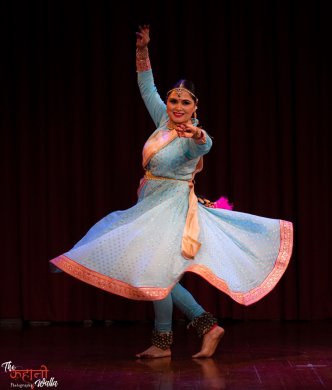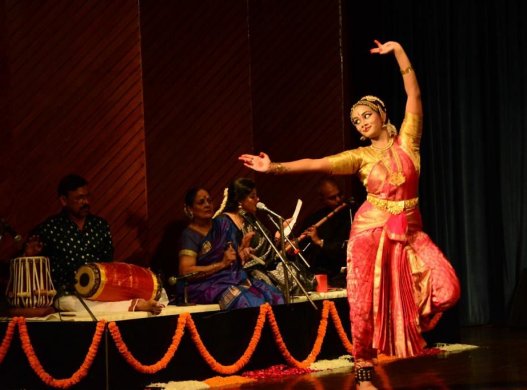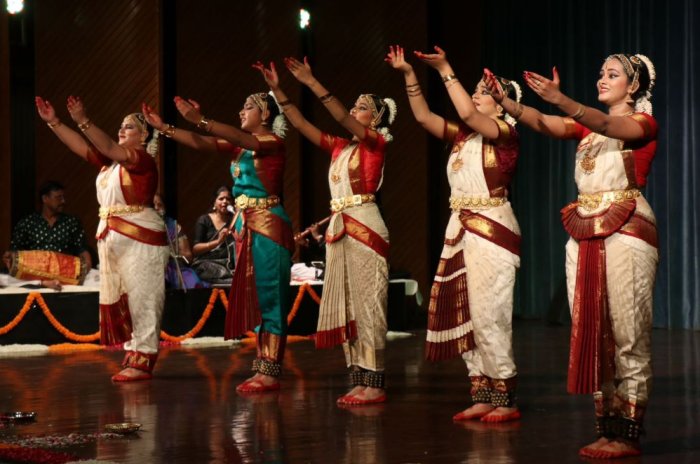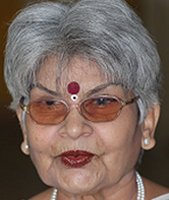
|   |

|   |
Disciples of two iconic Gurus in Bharatanatyam and Kathak recitals - Manjari Sinha e-mail: manjari@sinha.com October 12, 2023 The time-tested Guru-Shishya Parampara has transmitted our arts through time immemorial. That the Guru becomes a pivotal point, especially in the transmission of Indian classical arts, was proved once again when two highly venerated Gurus showcased their disciples in Bharatanatyam and Kathak dance styles recently at two different venues in Delhi. The Tamil Sangam presented an evening of Bharatanatyam by the disciples of Guru Kanaka Srinivasan, while Guru Sunayana Hazarilal, the doyen of Banaras Gharana belonging to the Janaki Prasad Parampara showcased her talented disciple Aruna Swamy in a solo Kathak performance at the Triveni Kala Sangam. Pt. Janaki Prasad was the founder of Banaras Gharana Kathak and a Sanskrit scholar who added new mnemonic syllables to the Kathak dance vocabulary. These are the pure dance bols called 'Natawari', quite different from the tabla and pakhawaj bols. Ustad Ashiq Hussain, Pt. Hazarilal and Maharaj Krishna Kumar were the noted stalwarts of the Janaki Prasad Gharana. After their passing away, Sunayana Hazarilal is the senior most practitioner of this Gharana and a dedicated Guru, carrying forward the tradition through her own institution Natawari Sansthan and Bharatiya Vidya Bhavan's Sangeet & Nartan Shiksha Peeth, Mumbai, as the Head of the Kathak Department. Trained under Sunayana Hazarilal's Hong Kong based disciple Neesha Jhaveri and groomed further under Guru Sunayana Hazarilal herself, Aruna Swamy is one of the most prominent artistes of the present generation practitioners of the Janaki Prasad Gharana. A graduate of the Indian Institute of Technology, Delhi, Aruna is a dedicated dancer who has performed in major dance festivals at home and abroad. She is the executive director of Natawari, Gurugram, which along with Natawari, Mumbai is the primary academy for the Janaki Prasad style Kathak of Banaras Gharana.  Aruna Swamy (Photo: The Kahani Walla Photography) Opening her performance at Triveni Sabhagar with Shiva Vandana in Jog-Kauns, written by Pt. Jagatdhar Bhatt, a Sanskrit scholar from Kashmir, she continued invoking Shiva's grace and majesty with "Shiva Shankar Mahadeva", a composition of Dr. Prabha Atre in raga Shankara set to teentaal. The pulsating padhant by Sunayana led the competent orchestra comprising Babar Latif, the son of renowned tabla maestro Ud. Latif Ahmed Khan of Dilli Gharana on tabla, Shuheb Hasan of Moradabad Gharana on vocal and harmonium, and Rais Ahmed Khan on sitar, enlivened the dancing especially the Kavittas like "Parwati ardhaang sohe..." in the Chhand of Misra Jati (seven beats) and the emphatic Tihais. Sunayana also incorporated the 'Barakhadi'. Nritta segment commenced with the slow graceful movements of Thaat and continued with the rhythmical Uthaan, Tode-Tukde, Tripalli Paran with three Pallas of 'Bolon ke Tode' where at times the tabla sounded overpowering. The medium tempo of teentaal showcased the "takit takit tak" Ladi and the unique Chakkardars created with the 'Barakhadi', a series of twelve compositions that can create innumerable new ones in the hands of a gifted dancer, originally created by Pt. Janaki Prasad and his disciples like Pt. Heera Lal. Sunayana's recitation of the bols especially the 'Bedum Rela of Natawari Bols' was terrific. It was heartening to find Aruna also imbibing the nuanced parhant. The expressive visage of the sensitive dancer portrays the agony and apprehensions of a Khandita Nayika jilted by her lover who gives vent to her anger upon noticing the tell-tale marks of infidelity, emoting to the Thumri "Jao jao batiyaan na banao" in raga Kalawati, before the spritely joy of spring was recaptured in the concluding Tarana in raga Basant, set ton Drut Ektal. The Tarana also had a scintillating sequence of 'Sawal-Jawab'. It was a lively repartee between the challenging parhant of the Guru, the demanding statements of the tabla, and the quick-witted reciprocation by the dynamic dancer. One only wished Aruna had a proper foot mike so that her intricate footwork was equally audible and was not drowned in the voluminous tabla and parhant. Bharatanatyam by the disciples of Guru Kanaka Srinivasan Guru Kanaka Srinivasan is an authentic exponent of the Vazhuvoor bani, one of the oldest styles of Bharatanatyam. Herself the senior most disciple of Vazhuvoor B. Ramaiah Pillai, a direct descendent of the Gurus who nurtured this bani, Kanaka Srinivasan has preserved the feminine grace of this style and propagated it further nurturing its nuances in her students with great care. This observation came forth when the Tamil Sangam presented a delightful evening of Bharatanatyam by her disciples. Her crisp nattuvangam along with the live orchestra comprising vocals by Sudha Raghuraman, mridangam by R. Kesavan, and flute by G. Raghuraman was an added attraction of this evening's Bharatanatyam performance by six of her students. The solo, duet, trio, and group numbers established her mark as an imaginative choreographer and a compassionate Guru too, who wanted to showcase all her students in a judicious way. The auspicious opening with the traditional Thodaya Mangalam, a characteristic of the Vazhuvoor style, which is sung during the Aarti for the Gajasamhara Murthi in the village temple, gave the recital an unusual and different feel from the very beginning. The invocation "Jaya shuddha purivasa..." was followed by the Pushpanjali "Jham Jham..." in raga Tilang, set to adi talam establishing the perfect anga shuddha of the well-trained dancers namely Megha Mohandas, Ananya Arora, Rasika Sachdeva, Nandini Bhalla, Medha Sivakumar and Aahna Arora.  Invocation to Sri Ganesha, the remover of all obstacles with "Sri Vighnarajam bhaje", the beautiful composition of Oothukadu Venkata Subbaiyar in raga Gambhira Nattai set to Khanda Nadai, was performed solo by Rasika Sachdeva. "Maa mayura" in raga Bilahari, adi talam came as a duet by Ananya and Aahna Arora, where the younger one would enact the mayura (peacock) and the taller one would ride on the mayura, both seeking blessings of Lord Kartikeya. In this song composed by Mazhavayi Chidambara Bharathi, the18th century composer, the poet pleads with Kartikeya to sit on his vaahan, and quickly come to protect him and bless him. The composer uses Anuprasa and Shlesha Alankars of poetics where the usage of the same word, repeatedly gives different meanings. Sri Rudram, from the central and important fourth division out of the seven divisions of Yajur Veda, was performed as a trio by three dancers. The Shiva Panchakshara Mantra represents the very core of Sri Rudram. Two verses were chosen for detailed delineation. The rhythmic patterns beautifully woven by Lalgudi Sri Ganesh with sollukattus were interspersed between every two lines of the verses. Sudha Raghuraman had not only composed it in raga Revathy set to adi talam, but her impressive singing along with the emphatic recitation of the sollukattus, also enhanced the powerful performance underlining the various attributes of Shiva. "Kanna vaa," a soulful composition by poet Ambujam Krishna was a Ragamalika piece, set to adi talam presented by Aahna. Krishna was praised here as a child, as a small boy, a young lad, and finally as the supreme. "Ananda natamaduvar Thillai" in ragam Poorvi Kalyani was a solo by Megha Mohandas. The popular composition of Neelakantha Sivan vividly brought out the joyous cosmic dance of Nataraja, the presiding deity of Chidambaram. "Bhajare Manasa Raghuveera" composed by Mysore Vasudevacharya in praise of Maryada Purushottam Rama, was performed by four dancers where Guru Kanaka Srinivasan chose three episodes from the Ramayana to highlight his prowess with small tableaus. The first one was about Rama slaying the demons Khara and Dushana while protecting the sacrificial Yajna of Sage Viswamitra. The second one depicted Rama lifting the Shiva Dhanush at King Janaka's court, and marrying Sita. The last was the annihilation of Ravana where Kesavan enhanced the 'Rama-Ravana Yuddha' with his powerful mridangam. This melodious piece in ragam Abheri was set to adi talam.  "Krishna Mukunda Murare," a lilting composition of Papanasam Sivan in Yamuna Kalyani was danced by the entire group. The composer recounts the leelas of the young Krishna. The focus was on the Kalinga Mardanam episode, where the child Krishna overpowers the demon serpent Kalinga, signifying the victory of good over evil. The evening climaxed with the beautifully sung Lalgudi G Jayaraman's Thillana in raga Maand showcasing nritta patterns with intricate footwork that got them a standing ovation.  Manjari Sinha has an M.A. in Sanskrit and Music, and trained in vocal, tabla, sitar and Kathak dance. She has regular columns in national dailies as a music and dance critic. |